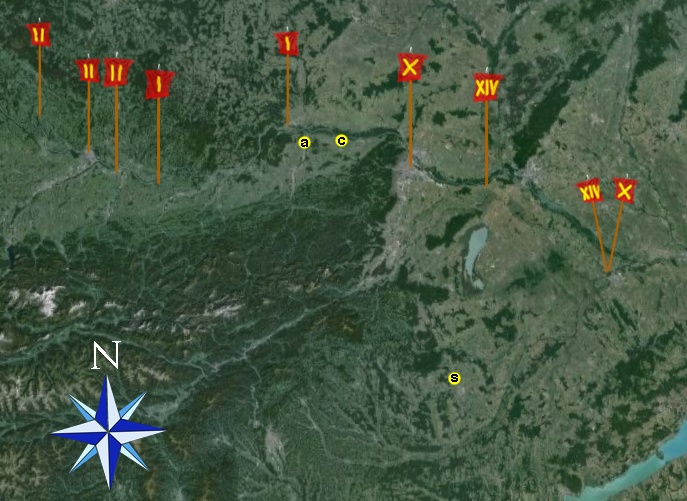
This page created 21 June 2014, and last modified: 2 October 2015 (map and commentary added)

The Lanciarii Sabarienses is listed (98/9.28 in Ingo Maier's numbering scheme) as the 8th of the 12 legiones palatinae in the Magister Peditum's infantry roster; it is assigned (102/5.134) to the Magister Equitum's Gallic command. Its shield pattern (92#9), as found in various manuscripts under the label (92.i) Sabarienses, is shown below:

The shield pattern is simple, showing a large red boss (pink in M), an unadorned maroon main ground (red in M; purple in B), and a yellow rim. The pattern that is closest to that of the Lanciarii Sabarienses in the Notitia is that of the Cimbriani (98/9.31), another western palatine legion, but assigned to the command of the Comes Africae; it also features a yellow-rimmed plain maroon main ground, but with a smaller yellow boss.
The position of the Lanciarii Sabarienses in the list of the units assigned to the Gallic command (102/5.217ff) seems to indicate that it was a comitatenses unit when the Notitia was first drawn up (since it there comes after the command's auxilia palatina units, and amongst the legiones comitatenses units), but was later promoted to the palatine status it is recorded having in the Magister Peditum's infantry roster. Six of the 12 palatine legions in the western empire appear to be such recently upgraded units judging by their anomalous positioning in the lists of the field commands they are assigned to. This is somewhat surprising, because their positioning in the illustrations section correctly corresponds to their position in the Magister Peditum's roster, and illustrations cannot be updated as easily as text, and the Magister Equitum's Gallic command list seems to bear many indications of being modified even more recently than that of the Magister Peditum. This would imply that when the Gallic list was modified, it was not replaced in toto, but amendments were, at least in some cases, appended to it, in the manner of the US Constitution.
While the name Lanciarii comes from the lancea, a spear suitable for both thrusting and throwing, this does not necessarily imply the Lanciarii Lauriacenses was equipped with this weapon, since the title lanciarii (or lancearii) had become the designation of elite guards in the later 3rd century; we even hear of mounted lanciarii, as attested by inscriptional evidence (AE 1981, 777) where the gravestone of one Aurelius Gaius describes him (in Greek) as an "ippeus lankiaris". There are a number of lanciarii units listed in the Notitia, some of which are obviously elite units, while some have no such indication.
The name Sabarienses comes from Sabaria (formerly Colonia Claudia Savariensum, and now modern Szombathely in Hungary), the main city of the province of Pannonia Prima. It is notable that three other western Lanciarii units have names relating to locations garrisoned by units under the command of the Dux Pannoniae primae et Norici ripensis: the Lanciarii Comaginenses (98/9.134), under the Comes Illyricum; the Lanciarii Augustenses (21.20), under the Magister Militum per Illyricum; and the Lanciarii Lauriacenses (98/9.133), also under the Comes Illyricum. Since there are four limitanei legions under the Dux, it would appear likely that each of these four units is derived from one of the four legions under the Dux. Since Legio II Italica appears to have been headquartered (145.27) at Lauriacum, it is almost certainly the progenitor of the Lanciarii Lauriacenses. Which of Legio I Noricum, Legio X Gemina and Legio XIV Gemina correspond to the other three units is less obvious.

However, looking at the locations of the legionary detachments stationed along the Danube in what is now Austria gives a reasonable indication that the Lanciarii Augustenses is most likely to derive from Legio I Noricum, since Augustiana ("a" in the above map) is most closely positioned to a detachment of that legion, while the Lanciarii Comaginenses is most likely to derive from Legio X gemina, since Comagina ("c" in the above map) is most closely positioned to a detachment of that legion, leaving the Lanciarii Sabarienses to Legio XIV gemina, which is most closely positioned to Savaria ("s" in the above map).

Return to the Notitia alphabetical unit list page.
Return to my Notitia index page.